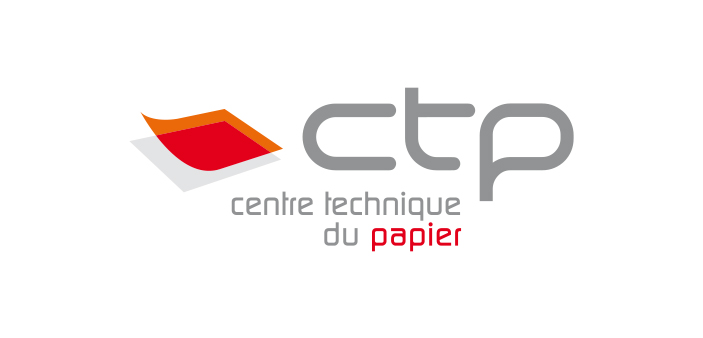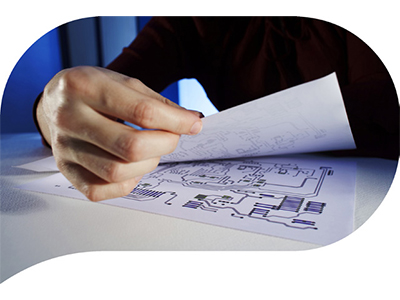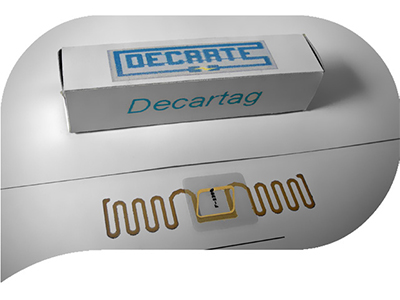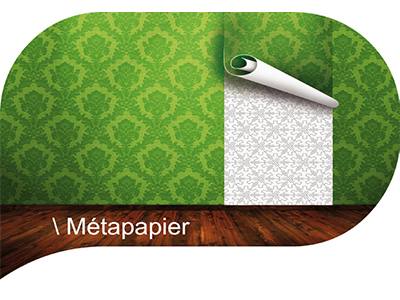
CTP
The economic markets for the different grades of paper/board represent significant volumes and turnover. The magazine printing, ticketing, packaging, sanitary paper or special paper sectors can benefit from higher added-value products thanks to new integrated functionalities such as printed or hybrid electronics!
The CTP’s objective is to provide a range of skills to material manufacturers, printers/converters and decision-makers in order to assist them during the “concept to industrial stage” process. With this aim in mind, the CTP has developed a national and international network of academic and industrial partners to design, implement and produce the technological building blocks required to develop a complete functional system.
At CTP, experts from several teams are involved in printed electronics projects. The CTP has pilot printing equipment to design demonstrators and adapt printing processes to electronic inks. Furthermore, it has incorporated this topic into the social & economic reality of sustainable development. Indeed, as 70% of paper/board consumed in Europe is recycled, and even 90% for corrugated board, paper is a recyclable substrate that is widely recycled! This array of resources is completed by laboratories dedicated to physical tests and chemical analyses and a whole range of laboratory and pilot scale printing solutions.
The applications of printed hybrid electronics are huge. Few examples of projects in the CTP’s portfolio that cover the entire TRL scale are given below:
• The Decarte project enabled the creation of an RFID tag complying with EPC GEN 2 standard which is integrated during the production of packaging based on folding boxboard or corrugated boxboard with very interesting production costs.
• The MetaPaper project was at the origin of a printed technology designed to filter electromagnetic waves selectively on wall papers or on other substrates. Several products have been made at an industrial stage (for filtering Wifi or GSM waves).
• The THID project has demonstrated the feasibility of developing a reliable and low-cost chipless RFID tag. Encoding is situated in the bulk of the substrate or on its surface depending on the technology used. The applications could include the fields of authentication and identification.
• The PEPS project, which was coordinated by the CTP, resulted in several demonstrators involving printed display units powered directly by the energy provided by the mobile phone. The systems are autonomous and do not require a battery.
• A3PLE is a European project coordinated by the CTP. Its objective was to create printed demonstrators (size ranging from a credit card to A0). The applications selected include resistors, gas and temperature sensors, transistors, display units and memory systems.
• The Greenanofilms project aims to design high-resolution nano-organised films made by self-assembly of bio-sourced raw materials for very high value-added applications (photovoltaic panels).
• The Stick’it project aims to develop a new technology to manufacture aerials, filters and other passive components using flexible materials.
• The Macéo project consists in developing new bio-sourced and renewable substrates mainly made of cellulose possessing dielectric properties that are suitable for radiofrequency (terahertz) domains, RFID tag or electromagnetic wave filtering purposes.
L’objectif du CTP est de mettre au service des sociétés de production de matériaux, des imprimeurs/ transformateurs et des donneurs d’ordres, un ensemble de compétences pour les accompagner dans la mise en oeuvre « de l’idée au stade industriel ».
Pour ce faire, le CTP a développé un réseau national et international de partenaires académiques et industriels qui permet de concevoir, réaliser et produire les briques technologiques nécessaires au développement d’un système fonctionnel complet.
Au sein même du CTP, les experts de plusieurs équipes sont impliqués dans l’électronique imprimée. Le CTP dispose d’équipements d’impression pilote pour concevoir des démonstrateurs et adapter les procédés d’impression aux encres électroniques. Par ailleurs, il inscrit cette thématique dans la réalité socio-économique du développement durable. En effet, avec le recyclage d’environ 70% des papiers/cartons consommés en Europe et 90% sur des sortes telles que le carton ondulé, le papier est un support recyclable et largement recyclé ! Des laboratoires d’essais physiques, d’analyses chimiques et tout un ensemble de moyens d’impression de l’échelle laboratoire au stade pilote viennent compléter le dispositif.
Les applications de l’électronique imprimée ou hybride sont très vastes. Voici quelques exemples dans le portefeuille de projets du CTP pour couvrir toute l’échelle TRL.
- Decarte a permis de créer un tag RFID au standard EPC GEN 2 intégré durant la fabrication des étuis en carton plat ou ondulé à des coûts de production très séduisants.
- MetaPapier est à l’origine d’une technologie imprimée qui filtre les ondes électromagnétiques de façon sélective sur papiers peints ou autres supports. Plusieurs produits sont réalisés au stade industriel (wifi ou GSM).
- THID a permis de prouver la faisabilité de développer un tag RFID sans puce, robuste et bas coût. Les codages se font dans l’épaisseur du substrat ou en surface suivant la technologie. Les applications pourraient toucher les domaines de l’authentification et de l’identification.
- PEPS, piloté par CTP, a débouché sur plusieurs démonstrateurs mettant en oeuvre des afficheurs imprimés et directement alimentés par l’énergie apportée par le téléphone mobile. Les systèmes sont autonomes et ne comportent pas de batterie.
- A3PLE, est un projet Européen piloté par le CTP dont l’objectif a été de réaliser des démontreurs imprimés (taille : carte de crédit à affiche A0). Les applications choisies intègrent des résistances, des capteurs de gaz et de température, des transistors, des afficheurs et des mémoires.
- Greenanofilms vise à concevoir des films nano-organisés à haute résolution, obtenus par l’auto-assemblage de matières premières végétales pour des applications à très haute valeur ajoutée (photovoltaique).
- Stick’it vise à développer une nouvelle technologie pour réaliser des antennes, des filtres et autres composants passifs sur des matériaux flexibles.
- Macéo, consiste à mettre au point de nouveaux substrats bio-sourcés et renouvelables, essentiellement à base de cellulose, ayant des propriétés diélectriques adaptées pour un usage en radiofréquence (térahertz) comme la RFID ou le filtrage électromagnétique.
Domaine Universitaire
CS 90251
38044 GRENOBLE Cedex 9
Contact
Contact Technologie
IMPRESSIONS GRAPHIQUES INTERACTIVES
Laurent LENGLET
Tél : +33 (0)3 27 98 33 00
laurent.lenglet@webCTP.com
Contact Presse et Communication
Sandrine PAPPINI
Tél : +33 (0)4 76 15 40 83
sandrine.pappini@webCTP.com



